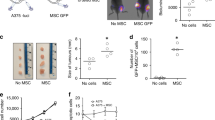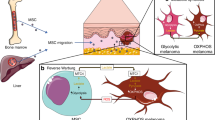Abstract
For cancer cells to proliferate, a balance must be built between biomass-forming, glucose-metabolized intermediates and ATP production. How intrinsic glucose carbon flow regulates this balance remains unclear. Here we show that mitochondrial phosphoenolpyruvate carboxykinase (PCK2), the hub molecule linking tricarboxylic acid (TCA) cycle, glycolysis and gluconeogenesis by conversion of mitochondrial oxaloacetate (OAA) to phosphoenolpyruvate, regulates glucose carbon flow direction in stem-like cells that repopulate tumors (tumor-repopulating cells (TRCs)). PCK2 downregulation accelerated biosynthesis and transportation of citrate from mitochondria to the cytosol, leading to cytosolic glucose carbon flow via OAA–malate–pyruvate and acetyl-CoA–fatty acid pathways in TRCs. On the other hand, downregulating PCK2 hindered fumarate carbon flows in TCA cycle, leading to attenuated oxidative phosphorylation. In pathological terms, PCK2 overexpression slowed TRC growth in vitro and impeded tumorigenesis in vivo. Overall, our work unveiled unexpected glucose carbon flows of TRCs in melanoma that have implications for targeting metabolic aspects of melanoma.
This is a preview of subscription content, access via your institution
Access options
Subscribe to this journal
Receive 50 print issues and online access
$259.00 per year
only $5.18 per issue
Buy this article
- Purchase on Springer Link
- Instant access to full article PDF
Prices may be subject to local taxes which are calculated during checkout






Similar content being viewed by others
References
Cairns RA, Harris IS, Mak TW . Regulation of cancer cell metabolism. Nat Rev Cancer 2006; 11: 85–95.
Koppenol WH, Bounds PL, Dang CV . Otto Warburg's contributions to current concepts of cancer metabolism. Nat Rev Cancer 2011; 11: 325–337.
Vander Heiden MG, Cantley LC, Thompson CB . Understanding the Warburg effect: the metabolic requirements of cell proliferation. Science 2009; 324: 1029–1033.
Owen OE, Kalhan SC, Hanson RW . The key role of anaplerosis and cataplerosis for citric acid cycle function. J Biol Chem 2002; 277: 30409–30412.
Pollard PJ, Briere JJ, Alam NA, Barwell J, Barclay E, Wortham NC et al. Accumulation of Krebs cycle intermediates and over-expression of HIF1alpha in tumours which result from germline FH and SDH mutations. Hum Mol Genet 2005; 14: 2231–2239.
Xiao M, Yang H, Xu W, Ma S, Lin H, Zhu H et al. Inhibition of alpha-KG-dependent histone and DNA demethylases by fumarate and succinate that are accumulated in mutations of FH and SDH tumor suppressors. Genes Dev 2012; 26: 1326–1338.
Costello LC, Franklin RB . 'Why do tumour cells glycolyse?': from glycolysis through citrate to lipogenesis. Mol Cell Biochem 2005; 280: 1–8.
Kuhajda FP, Pizer ES, Li JN, Mani NS, Frehywot GL, Townsend CA . Synthesis and antitumor activity of an inhibitor of fatty acid synthase. Proc Natl Acad Sci USA 2000; 97: 3450–3454.
Zaidi N, Swinnen JV, Smans K . ATP-citrate lyase: a key player in cancer metabolism. Cancer Res 2012; 72: 3709–3714.
Liu J, Tan Y, Zhang H, Zhang Y, Xu P, Chen J et al. Soft fibrin gels promote selection and growth of tumorigenic cells. Nat Mater 2012; 11: 734–741.
Li Y, Luo S, Ma R, Liu J, Xu P, Zhang H et al. Upregulation of cytosolic phosphoenolpyruvate carboxykinase is a critical metabolic event in melanoma cells that repopulate tumors. Cancer Res 2015; 75: 1191–1196.
Leithner K, Hrzenjak A, Trotzmuller M, Moustafa T, Kofeler HC, Wohlkoenig C et al. PCK2 activation mediates an adaptive response to glucose depletion in lung cancer. Oncogene 2015; 34: 1044–1050.
Vincent EE, Sergushichev A, Griss T, Gingras MC, Samborska B, Ntimbane T et al. Mitochondrial phosphoenolpyruvate carboxykinase regulates metabolic adaptation and enables glucose-independent tumor growth. Mol Cell 2015; 60: 195–207.
Beier D, Hau P, Proescholdt M, Lohmeier A, Wischhusen J, Oefner PJ et al. CD133(+) and CD133(-) glioblastoma-derived cancer stem cells show differential growth characteristics and molecular profiles. Cancer Res 2007; 67: 4010–4015.
Klein WM, Wu BP, Zhao S, Wu H, Klein-Szanto AJ, Tahan SR . Increased expression of stem cell markers in malignant melanoma. Mod Pathol 2007; 20: 102–107.
Hatzivassiliou G, Zhao F, Bauer DE, Andreadis C, Shaw AN, Dhanak D et al. ATP citrate lyase inhibition can suppress tumor cell growth. Cancer Cell 2005; 8: 311–321.
Kolukula VK, Sahu G, Wellstein A, Rodriguez OC, Preet A, Iacobazzi V et al. SLC25A1, or CIC, is a novel transcriptional target of mutant p53 and a negative tumor prognostic marker. Oncotarget 2014; 5: 1212–1225.
DeBerardinis RJ, Lum JJ, Hatzivassiliou G, Thompson CB . The biology of cancer: metabolic reprogramming fuels cell growth and proliferation. Cell Metab 2008; 7: 11–20.
Zelle RM, de Hulster E, van Winden WA, de Waard P, Dijkema C, Winkler AA et al. Malic acid production by Saccharomyces cerevisiae: engineering of pyruvate carboxylation, oxaloacetate reduction, and malate export. Appl Environ Microbiol 2008; 74: 2766–2777.
Yang H, Zhou L, Shi Q, Zhao Y, Lin H, Zhang M et al. SIRT3-dependent GOT2 acetylation status affects the malate-aspartate NADH shuttle activity and pancreatic tumor growth. EMBO J 2015; 34: 1110–1125.
Selak MA, Armour SM, MacKenzie ED, Boulahbel H, Watson DG, Mansfield KD et al. Succinate links TCA cycle dysfunction to oncogenesis by inhibiting HIF-alpha prolyl hydroxylase. Cancer Cell 2005; 7: 77–85.
Sudarshan S, Sourbier C, Kong HS, Block K, Valera Romero VA, Yang Y et al. Fumarate hydratase deficiency in renal cancer induces glycolytic addiction and hypoxia-inducible transcription factor 1alpha stabilization by glucose-dependent generation of reactive oxygen species. Mol Cell Biol 2009; 29: 4080–4090.
Gyorffy B, Surowiak P, Budczies J, Lanczky A . Online survival analysis software to assess the prognostic value of biomarkers using transcriptomic data in non-small-cell lung cancer. PLoS One 2013; 8: e82241.
Montal ED, Dewi R, Bhalla K, Ou L, Hwang BJ, Ropell AE et al. PEPCK coordinates the regulation of central carbon metabolism to promote cancer cell growth. Mol Cell 2015; 60: 571–583.
Burgess SC, He T, Yan Z, Lindner J, Sherry AD, Malloy CR et al. Cytosolic phosphoenolpyruvate carboxykinase does not solely control the rate of hepatic gluconeogenesis in the intact mouse liver. Cell Metab 2007; 5: 313–320.
Mendez-Lucas A, Hyrossova P, Novellasdemunt L, Vinals F, Perales JC . Mitochondrial phosphoenolpyruvate carboxykinase (PEPCK-M) is a pro-survival, endoplasmic reticulum (ER) stress response gene involved in tumor cell adaptation to nutrient availability. J Biol Chem 2014; 289: 22090–22102.
Chowdhury F, Na S, Li D, Poh YC, Tanaka TS, Wang F et al. Material properties of the cell dictate stress-induced spreading and differentiation in embryonic stem cells. Nat Mater 2010; 9: 82–88.
Acknowledgements
This work was supported by National Basic Research Program of China (2014CB542100), National Natural Science Foundation of China (81472653, 81530080, 81661128007) and CAMS Initiative for Innovative Medicine (2016-I2M-1-007).
Author information
Authors and Affiliations
Corresponding author
Ethics declarations
Competing interests
The authors declare no conflict of interest.
Additional information
Supplementary Information accompanies this paper on the Oncogene website
Supplementary information
Rights and permissions
About this article
Cite this article
Luo, S., Li, Y., Ma, R. et al. Downregulation of PCK2 remodels tricarboxylic acid cycle in tumor-repopulating cells of melanoma. Oncogene 36, 3609–3617 (2017). https://doi.org/10.1038/onc.2016.520
Received:
Revised:
Accepted:
Published:
Issue Date:
DOI: https://doi.org/10.1038/onc.2016.520
This article is cited by
-
Identifying the novel key genes in renal cell carcinoma by bioinformatics analysis and cell experiments
Cancer Cell International (2020)
-
The different expression of glycogen phosphorylases in renal clear cell renal carcinoma and chromophobe renal carcinoma
Clinical Proteomics (2020)
-
Hypoxia-reprogrammed tricarboxylic acid cycle promotes the growth of human breast tumorigenic cells
Oncogene (2019)



